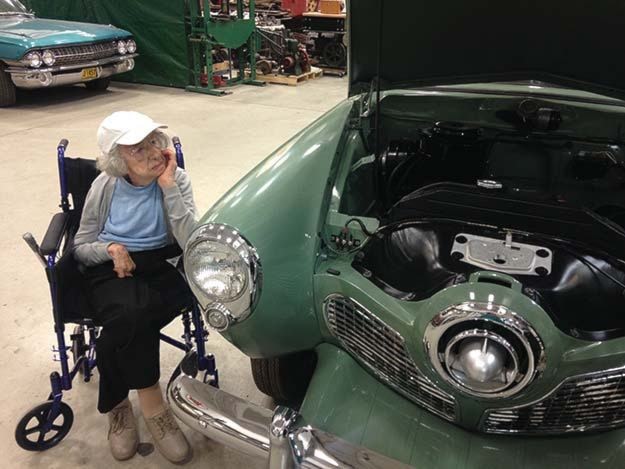Submitted by Nicole Mueller
Reynolds-Alberta Museum
Staring down into the restoration shop, a young boy admires the vintage, sporty two-door sedan being put back together.
“Wow, I bet that car was a lot of fun to drive,” he says to his Dad.
Jean McWhinnie leans over and says, “It was.”
What the boy doesn’t know is that Jean, as a young woman in the 1950s, had driven that very Studebaker Champion Deluxe.
The Reynolds-Alberta Museum’s Champion Deluxe was purchased by Jean and her brother back in 1951.
“I’m not 100 per cent sure, but I think it was her first car,” explains David McWhinnie, Jean’s son. “Her and her brother had bought the car brand new. After she was married, my uncle kept the car for another five to six years and then the car ended up back in our yard and sat there for 25 years, then it went into storage,” he adds.
While the Studebaker sat in their back yard, David says it was used as a children’s playhouse.
David explains that his father had always intended to restore the car, but never found the time. “He had rebuilt the motor but then it went back into storage for 20 years,” he says. “Then it went to the museum (in 2006).”
This Champion Deluxe is now part of the museum’s vast transportation collection.
The museum-quality, full body-off-frame restorations, such as the one done on this Studebaker, follow a certain process. Every component of the vehicle is disassembled, cleaned, repaired or replaced. Since the museum first opened in 1992, the museum’s restoration shop has completed more than 28 full body-off-frame restorations of cars, tractors, and stationary engines.
“Conservation is always our first choice, says Darren Wiberg, Head, Restoration Services. “We always want to conserve first. The expenses are considerably less and you have more historical materials left.”
Several areas required sheet metal replacement, including the driver and passenger floor pan, and the trunk pan. “These are typical areas of deterioration with classic vehicles,” explains Justin Cuffe, the museum’s Curator, Transportation Collections.
Following dent and rust repairs to the body panels, the car was reassembled to check for fit and alignment issues.
“Once we were happy with the fit, the body was sprayed with protective epoxy and high-build primer,” explains Cuffe. “This was followed by hours of painstaking sanding and final fitting until the body was ready for its final spray of alkyd enamel “Shenandoah Green.”
During the restoration process, David would bring his mother to the museum so she could see for herself the work being done on her old Studebaker.
“From time-to-time, I’d bundle her up and come down to the museum so she could see the process (through the window into the restoration shop).”
Once the restoration of the car had been completed, Cuffe contacted David.
David says his mom was “over the moon” with how the restoration had turned out. For the first time in a long time, Jean saw her old Studebaker as it had looked when she first bought it brand new back in the 1950s. “She was very happy.”
The Champion Deluxe
The Champion was first produced in 1939 and was one of Studebaker’s best-selling models because of its low price, durable engine, and styling. In 1941, the bodies were given a more streamlined look.
In 1947, Studebaker completely redesigned the Champion and the Commander, making them the first new cars produced after the Second World War. That same year, Champion made up more than 65 per cent of the total sales for Studebaker.
The 2.8 L (169.9 cu. In.), 6-cylinder engine produced 80 HP in 1947. In 1950, output was increased to 85 HP.
One of the new styling features on these cars was the wrap-around rear window, available on the two-door cars from 1947 to 1951.
Popularly known as the “bullet-nose,” the Studebaker Champion was a radical departure from the traditional pre-war styling. The automotive industry adopted a new look following the Second World War. Studebaker represents one of the most distinctive automotive designs from the fifties.
The 1951 Champions were available in the Custom, Deluxe, or Regal trim level. Painted headlights and tail light rings were used only on Customs; Deluxe models had chrome headlight and tail light rings like the Regal, but not the chrome rocker panel mouldings of the Regal.
This 1951 Studebaker Champion Deluxe is a two-door, six-passenger sedan. The car has a 6-cylinder, inline, L-head, water-cooled engine. The original cost of the car was C$2,396.
